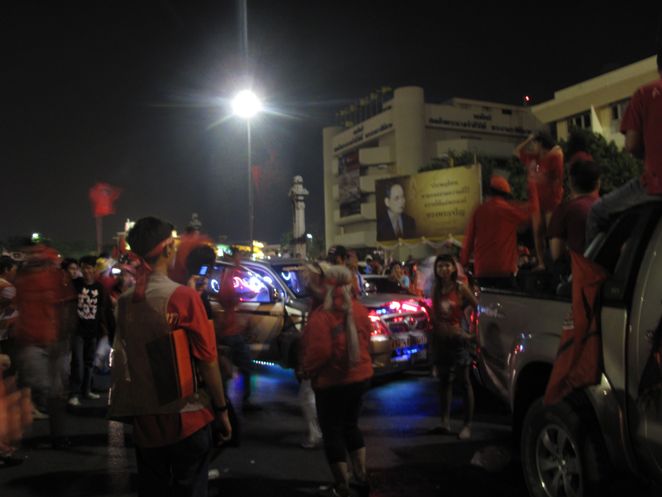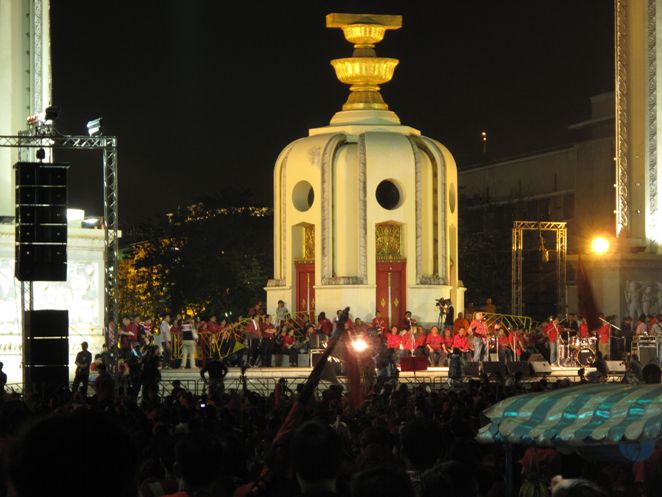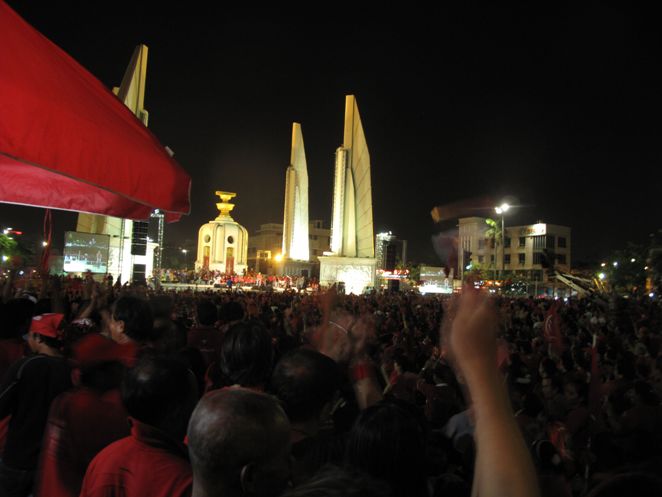At Democracy Monument on 20 February 2011, tens of thousands of UDD ‘Red Shirts’ gathered to mark nine months since the bloody crackdown on their anti-government rally at which more than 90 people were killed and nearly 1,900 injured.
At the protest, a sea of crimson colored almost every man, woman and child. Megaphones and loudspeakers ensured that speeches from the floor could be heard for kilometers. Every brief moment of attentive quiet was soon punctured by roars of cheers and the almost-deafening noise of thousands of plastic hand clappers. Pick-up trucks pumped out Thai pop accompanied by strobe lights.
Hundreds of trinket and food vendors manned the guttered corridors. Bracelets and amulets, coffee and cocktails, chicken legs and eggs; helium balloons, beers and cigarettes are all on offer. But the only cigarettes on sale, you’ll find, are Marlboro Red.
The term ‘red shirts’ belies the enormous variety of UDD paraphernalia; shirts, pants, headbands, wristbands, dolls, flags; Santa Claus, heart-shaped ‘love’ pillows and teddy bears. Slogans call for “double standards” to be revoked, “justice” to be dealt and former Thai Prime Minister Thaksin Shinawatra to be recalled from exile.
Book-sellers offer copies of UDD-sponsored Voice of Taksin. Spiral-bound copies of Thaksin’s recent complaint to the International Criminal Court (ICC) in the Hague, which claims to prove the government committed crimes against humanity in their response to the April/May protests, are also made available.
Closer to the stage, and the crowd has noticeably thickened. Men, women and children crouch atop trucks and sewerage tanks, in cars and on bitumen. Any small cordon of police give the impression that they’ve since given up any real attempt at surveillance; some wear their sympathies on their chest, pulling red scarves, like amulets, from inside their vests.
One may pass a Chaplin-esque character whose ‘costume’ involves fake breasts and belly, protruding nipples, army fatigues and a plastic M16. A woman grasps at his fingertips and squeals in mock horror when the ‘dummy’ squeezes back.
Above us, the flag of Bahrain has been attached, high up a telegraph pole, to a red shirt flag.
While beneath, crowds shuffle along in single file. Some of the gutters are spray-painted with doves and olive branches and the white outlines of bodies amiss. Here a mother of a slain protester has set up one of any number of memorials strewn through the protest site. The passing of her son, killed during the fatal protests last April, is remembered here in a display of candlelit photos. He is shown both at red shirt rallies, at his family home, and at the morgue. Laminated copies of his birth and death certificates, too, as further proof of his existence. Passerby quietly slip 20B notes into a red memorial box.
Keen to distribute mobile-phone footage of last year’s fatal protests, a vendor has set up plasma screens at his stall. The grainy footage, and the colours slightly surreal, a volley of bullets serves as soundtrack. On screen, a woman screams as a man drops to the ground. Beside me, a man gasps. Passersby linger, arms folded, and watch.
Thousands stayed glued through the night to the screens and speakers. Vendors continued to trawl the rows with foil sheets to serve as picnic rugs. Soon, some might have to dispense with hand clappers long since disfigured from overuse.
On the way home, the motorcycle driver asks: “You go to Democracy Monument?” “Yes.” “Good, khaap.” He flashes me a grin and a silver trinket of a fist-pumping Thaksin on his keyring, as we race away.
 Facebook
Facebook  Twitter
Twitter  Soundcloud
Soundcloud  Youtube
Youtube  Rss
Rss 

